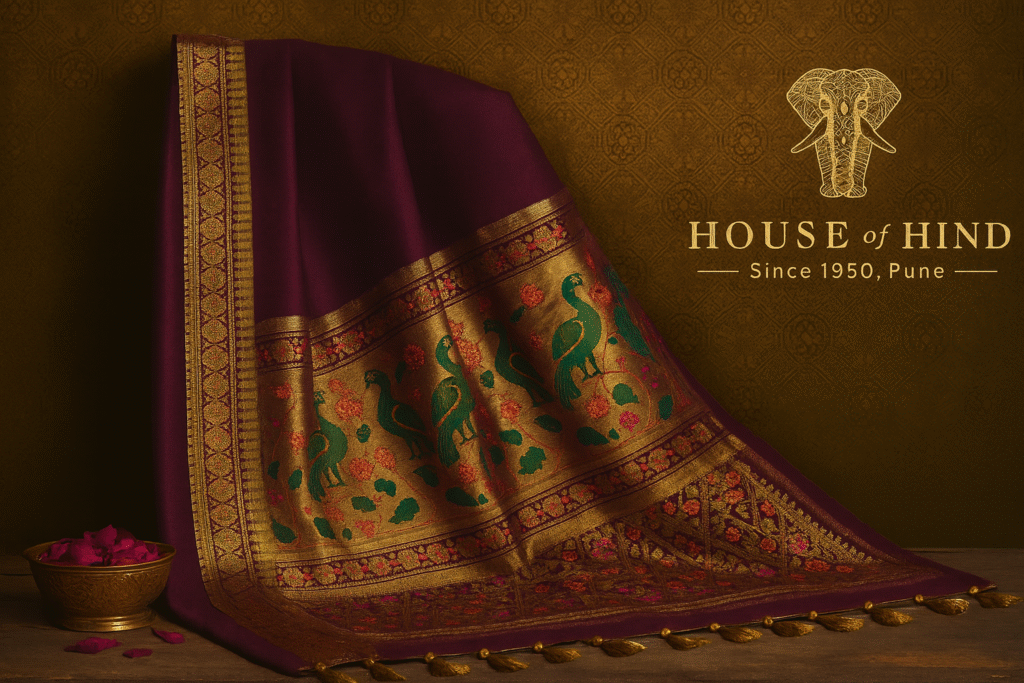Paithani saree—a timeless masterpiece woven with gold threads and peacock motifs—has long stood as the pride of Maharashtra. But in a world driven by reels, trends, and fast fashion, how does a centuries-old handloom art find space in Gen Z and millennial wardrobes? The answer lies in the creative vision of House of Hind, a brand that has transformed the narrative of heritage fashion into something fresh, youthful, and globally relevant.
The Legacy of Paithani: A Royal Weave from Yeola
At the heart of this story lies the Yeola Paithani saree, handwoven in the small town of Yeola near Nashik. Each thread carries a tale of devotion, artistry, and time. Once cherished by Peshwa queens and royal families, the traditional Paithani saree has always represented luxury, grace, and cultural identity.
But as the world moved toward western silhouettes and synthetic fabrics, the younger generation slowly drifted away from these heirlooms. House of Hind saw this gap—not as a decline, but as an opportunity to revive a legacy through design innovation and storytelling.
Redefining the Heritage Appeal
House of Hind didn’t just reintroduce the Maharashtrian Paithani saree; it reinvented it. The brand approached the saree not as an artifact but as a living canvas of art—something that could adapt, inspire, and move with time.
By infusing contemporary color palettes, lighter zari detailing, and playful motifs, they made the Paithani approachable for modern fashion lovers. The essence of handloom remains untouched, but the expression has become youthful, global, and relatable.
Why Gen Z and Millennials Are Falling in Love Again
Gen Z and millennials crave authenticity and storytelling. They are not just buying outfits—they are buying experiences, values, and identity. House of Hind connects with them by making the Paithani more than a saree—it becomes a statement of mindful fashion.
Here’s why the younger generation resonates with it:
-
Sustainable Craftsmanship: Every Paithani saree is handwoven using traditional looms, ensuring zero wastage and minimal environmental impact.
-
Cultural Pride: Wearing a Maharashtrian Paithani saree feels like owning a part of India’s royal history.
-
Modern Styling: Draped over sneakers, paired with crop blouses, or styled as fusion wear—the new-age Yeola Paithani saree is fashion-flexible.
-
Luxury with Meaning: The gold and silk threads symbolize conscious luxury—something Gen Z values deeply.
Craft Meets Creativity
Behind every traditional Paithani saree lies months of effort by skilled artisans. House of Hind collaborates directly with these weavers, ensuring fair wages and continuous skill development. The brand’s commitment is not just to fashion but to the people who keep the heritage alive.
Their design studios act as creative bridges between tradition and innovation. Here, designers study ancient motifs—like peacocks, parrots, and lotuses—and reinterpret them in minimalistic, geometric, and pastel-based versions that appeal to a contemporary aesthetic.
Styling the Paithani: The New-Age Statement
The modern fashion movement isn’t about replacing tradition—it’s about redefining it. House of Hind has inspired a generation to drape the Paithani with new energy.
Here’s how today’s youth are embracing it:
-
Festive Chic: Styling a soft Yeola Paithani saree with pearl jewelry and statement clutches.
-
Fusion Look: Layering a Paithani saree with denim jackets or belts.
-
Cultural Events: Opting for traditional Paithani sarees in minimal tones for college ethnic days or family gatherings.
-
Destination Weddings: Brides are now choosing Maharashtrian Paithani sarees for pre-wedding events to honor their roots.
These transformations show how the saree, once seen as heavy and traditional, has turned into a versatile fashion icon.
How House of Hind Balances Tradition and Trend
The magic lies in balance—House of Hind ensures that while the designs appeal to a younger crowd, the soul of Paithani remains untouched. Their focus areas include:
-
Preserving Authentic Weaves: Every saree is crafted in Yeola using pure silk and real zari.
-
Modern Storytelling: Through digital campaigns and visual storytelling, they bring out the emotional side of wearing a Paithani.
-
Sustainability as Core: Encouraging customers to buy less but better—to choose handwoven Paithani sarees that last generations.
-
Global Identity: Positioning Paithani as an Indian luxury that can stand alongside global designer wear.
The Visual Identity: Where Design Meets Heritage
As a graphic designer, the journey of House of Hind feels like a case study in visual storytelling. The brand’s imagery, typography, and textures reflect both royal heritage and modern minimalism. The color palette often draws inspiration from Paithani’s own hues—gold, emerald, ruby, and deep blue, but is presented through clean layouts and bold simplicity.
Every campaign image or product layout mirrors their philosophy: classic roots, modern vision. The result? A brand identity that speaks to both a 60-year-old connoisseur and a 22-year-old trendsetter.
Why This Revival Matters
The revival of the Maharashtrian Paithani saree is more than a fashion movement—it’s a cultural awakening. In a world of machine-made fast fashion, House of Hind’s mission reminds us that slow fashion is the real luxury. Each Yeola Paithani saree stands as proof that heritage can be chic, sustainable, and globally admired.
Key Takeaways for Modern Fashion Enthusiasts
-
Invest in craftsmanship, not quantity.
-
Support local artisans who preserve India’s textile legacy.
-
Experiment with your drape—tradition is flexible.
-
Choose heritage fashion for its meaning, not just its beauty.
The Future of Paithani: A Living Legacy
Thanks to House of Hind’s creative reinvention, the Paithani saree is no longer confined to grandmothers’ trunks—it’s on runways, red carpets, and Instagram grids. It’s a blend of authenticity and innovation, making the younger generation proud to flaunt their roots.
By reimagining the traditional Paithani saree through the lens of modern design, House of Hind has achieved something rare—it has made history fashionable again. And in doing so, it has woven a new dream for Indian handloom—one where every thread tells a story, and every story finds a future.
Read more article on techbullion
